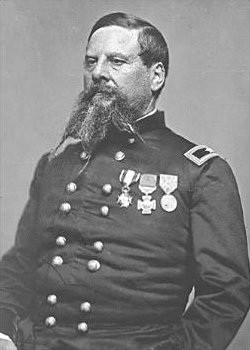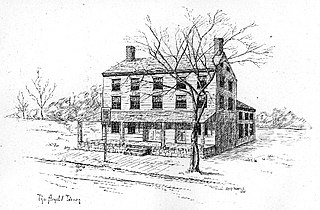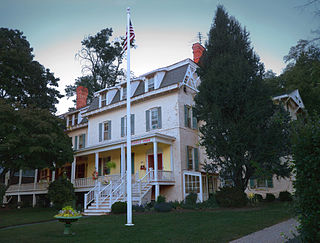
Morristown is a town in and the county seat of Morris County, in the U.S. state of New Jersey. Morristown has been called "the military capital of the American Revolution" because of its strategic role in the war for independence from Great Britain. Morristown's history is visible in a variety of locations that collectively make up Morristown National Historical Park, the country's first National Historical Park.

Jockey Hollow is the name of an area in southern Morris County, New Jersey, which was farmed in the 18th century by the Wick, Guerin, and Kemble families.

Acorn Hall is an 1853 Victorian Italianate mansion located at 68 Morris Avenue in Morristown, Morris County, New Jersey. It was added to the National Register of Historic Places on April 3, 1973, for its significance in architecture. It serves as the headquarters of the Morris County Historical Society, which operates Acorn Hall as a historic house museum.

Joseph Warren Revere was a career United States Navy and Army officer. He was the grandson of American Revolutionary War figure Paul Revere.

Morristown Green, most commonly referred to as the Green, is a historical park located in the center of Morristown, New Jersey, United States. It has an area of two and a half acres and has in the past served as a military base, a militia training ground, and an area for public executions. It is now a public park in which many community events are held. It was added to the National Register of Historic Places, listed as a contributing property of the Morristown District, on October 30, 1973.

Caroline Rose Foster was an American farmer and philanthropist who managed Fosterfields, a working farm in Morristown, New Jersey, United States. Beginning in 1910 and throughout her life, Foster challenged gender roles of the Progressive Era by wearing men's clothing including men's hats, pants, shoes, and tuxedos.

Sophie Adelaide Radford de Meissner was an American author, playwright, diplomat's wife, spiritualist and socialite.

Fosterfields, also known as Fosterfields Living Historical Farm, is a 213.4-acre (86.4 ha) farm and open-air museum at the junction of Mendham and Kahdena Roads in Morris Township, New Jersey. The oldest structure on the farm, the Ogden House, was built in 1774. Listed as the Joseph W. Revere House, Fosterfields was added to the National Register of Historic Places on September 20, 1973, for its significance in art, architecture, literature, and military history. The museum portrays farm life circa 1920.

Mary Crane Hone II was an American stage actress, campaign manager, political anti-war activist, and historical preservationist. She is best known for preserving Acorn Hall in Morristown, New Jersey.

Paul Revere was a lawyer, writer, public speaker, and civic member of Morristown, New Jersey. He was the great-grandson of American revolutionary figure Paul Revere, and his father was Navy officer and Union general Joseph Warren Revere.

The Sansay House is a residential dwelling in Morristown, New Jersey. It was built in 1807. In the early 19th century, it was the site of a French dancing school led by Monsieur Louis Sansay. On July 14, 1825, Louis Sansay held a ball in Lafayette's honor. Louisa Macculloch (1785–1863) and her daughter, Mary Louisa (1804–1888) were on the decorating committee for the reception.

The Morristown District, also known as the Morristown Historic District, is a historic district in the town of Morristown in Morris County, New Jersey. It was added to the National Register of Historic Places on October 30, 1973, for its significance in architecture, communications, education, military, politics, religion, social history, and transportation.

Julia Keese Nelson Colles (1840–1913) was an American historian, lecturer, and writer who lived in and studied Morristown, New Jersey.

Jacob Arnold's Tavern, also known as the OldArnold Tavern and the Duncan House, was a "famous" historic tavern established by Samuel Arnold circa 1740. Until 1886, it was located in Morristown Green in Morristown, New Jersey. In 1777 it served as George Washington's headquarters during the Revolutionary War, and it was the site of Benedict Arnold's first trial in 1780. The National Park Service claims "Much of [Morris]town's social, political, and business life was conducted at Arnold's Tavern" during the Revolutionary era.

Adams & Fairchild was a 19th century grocery store located beside the Morristown Green in Morristown, New Jersey. Circa 1882, it operated out of historic 1740s tavern, Arnold's Tavern, notable for its Revolutionary history.

The Hoffman Building, also known as The Arnold, was a Morristown, New Jersey structure completed before 1896.

Philip Henry Hoffman was an American tailor, banker, and building owner in Morristown, New Jersey.
Augustus Lefebvre Revere (1861-1910) was an American financier, banker, stock broker, and civic leader from Morristown, New Jersey. He was a member of the Morristown Club, the Morristown Golf Club, the Morristown Field Club, and the Washington Association of New Jersey, the Society of Colonial Wars, and the Memorial Day Association.

The Mount Kemble Home is a historic building located at 1 Mount Kemble Avenue in the town of Morristown in Morris County, New Jersey. Part of the Morristown Multiple Resource Area (MRA), it was added to the National Register of Historic Places on November 13, 1986, for its significance in architecture.

The Peter Kemble House is a historic house built around 1750 and located on Mount Kemble Avenue at Old Camp Road in Harding Township, New Jersey. It was documented by the Historic American Buildings Survey in 1937. It was added to the National Register of Historic Places on August 26, 1980 for its significance in commerce, military history, and government. The Georgian style house was added as a contributing property of the Tempe Wick Road–Washington Corners Historic District on August 25, 2000.






















